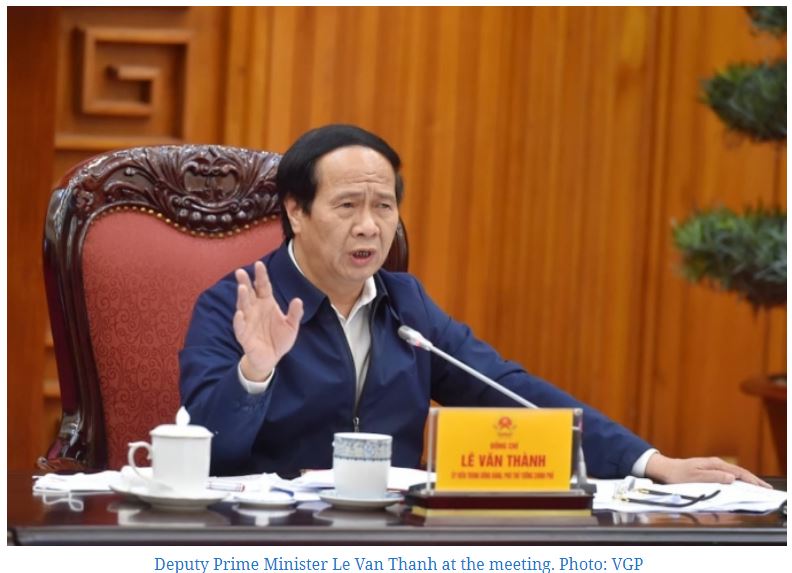Vietnam Gov’t urges businesses to limit trucks to border gates with China
A shift to the local market should be a long-term solution for Vietnam to avoid a similar situation at border gates with China in the future.
Vietnamese Government agencies are urged to actively work with their Chinese counterparts to resolve the current congestion at Vietnam-China border checkpoints, while businesses should refrain from sending more trucks to China.
Deputy Prime Minister Le Van Thanh stressed the view in a meeting on December 26 with localities and government agencies to address trade issues with China at border gates in the North of Vietnam.
“It is urgent to clear the congestion at Vietnam-China border checkpoints in Quang Ninh and Lang Son provinces, while local authorities should inform traders to find other routes to send their goods to the neighboring country,” Thanh said.
Thanh added businesses should be regularly updated on the situation at the border gate to revise their operation accordingly. In the meantime, localities should know in advance the number of trucks going to the border gates every day to take measures and avoid possible congestion.
For the past month, thousands of trucks have been stranded at the Vietnam-China border gates. A report from the Ministry of Industry and Trade (MoIT) revealed as of December 25, there remain 1,555 trucks in Quang Ninh and 4,204 in Lang Son pending customs clearance from the Chinese sides.
“80% of those trucks are carrying farm produce and fruits that are likely to perish in case of having to wait further for customs clearance,” Minister of Industry and Trade Nguyen Hong Dien said at the meeting.
Dien added the customs clearance at the Vietnam-China border gates continues to be slow, referring to 88 trucks getting clearance at Huu Nghi and Chi Ma stations in Lang Son province per day, while the Tan Thanh checkpoint is temporarily closed at the moment.
Chairman of the Lang Son Province People’s Committee Ho Tien Thieu said the province has so far held 50 dialogues with their Chinese counterparts in Guangxi Province to resolve congestion issues at the border gates, but strict measures under China’s “zero Covid” strategy remain a stumbling block.
“The Chinese customs authorities are tightening clearance measures, while Vietnamese truck drivers are not allowed to enter China. There will be Chinese drivers to drive the trucks in China,” Thieu added.
“Only eight trucks get clearance per hour, or 88 trucks per day at a border gate,” he said.
Changing mindset in agricultural production
Meanwhile, Vice Minister of Industry and Trade Tran Quoc Khanh attributed the ongoing problems to existing issues related to Vietnam’s agricultural production.
For years, local farm production has not been fully focused on market demand but based on the advantages of each locality, and farm produces trading with China is conducted mainly via unofficial routes of people to people.
Minister of Industry and Trade Nguyen Hong Dien also pointed out the lack of attention from the businesses to the domestic market with over 100 million people.
“The MoIT has been calling for businesses to promote domestic consumption via supermarkets or e-commerce,” Dien said.
Dien stressed the necessity for localities, business associations, and farmers to change the mindset of operation and take into consideration market signals for farm production.
In the short term, Deputy Prime Minister Thanh requested local authorities to continue working with the Chinese side to find a solution for the congestion issues, including an expansion of customs clearance time from eight to 12 hours per day.
Thanh also instructed the Ministry of Health, customs, and localities to form “green zone” and “green corridors” at border areas, to speed up customs clearance.
Meanwhile, businesses and traders should look at solutions to expand domestic consumption and take advantage of the market with 100 million people, in which products should be in line with market demand and meet food safety standards with clear origins.
“It is essential for Vietnam to invest in infrastructure and logistics development for storage at border gates,” Thanh said.
A report from the Vietnam Fruit & Vegetable Association estimates the ongoing congestion at border gates could cost Vietnamese businesses up to VND4 trillion (US$175.4 million).
Source: https://hanoitimes.vn/vietnam-govt-urges-businesses-to-limit-trucks-to-border-gates-with-china-319639.html


 Thailand
Thailand




